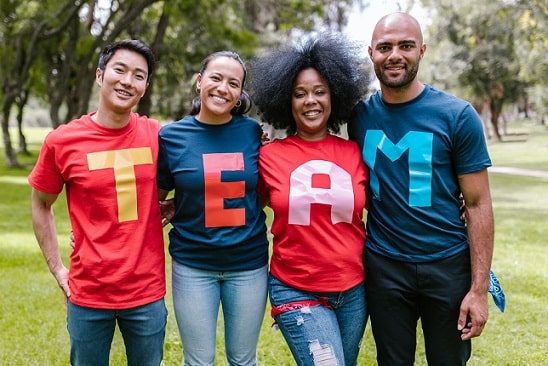Diversity Recruiting Strategies and How to Recruit Diverse Candidates: 15 Strategies
Diversity and inclusion in the workplace (D&I) is a topic that has entered the topmost important organizational issue in all companies worldwide. And no wonder, studies, and statistics show that fostering diversity in the workplace is key to improving processes, increasing innovation, growing profits, enhancing problem resolution, and understanding the customer better. In fact, there are numerous benefits of diversity and inclusion in the workplace.
Diversity and Inclusion in organizations have become the key that opens the door to better opportunities for both employers and employees.
Is your company offering inclusive jobs for people with disabilities? As an employer, you can publish your job offers on MyDisabilityJobs and reach thousands of qualified candidates.
However, achieving diversity in organizations is not an easy task and one of its most important points is the hiring of diverse and qualified talent. The diversity of a group includes multiple characteristics such as age, sex, gender, race, religion, nationality, abilities, etc., and achieving the participation of these groups in the selection processes can be a full-time job.
It requires a strong alienation with organizational goals and market trends, as well as a clear focus on what the company is trying to achieve and how many forces can get together to make it possible.
That is why today we show you 15 strategies you can implement to make selection processes successful when it comes to bringing diversity to the workplace.
What is diverse recruiting?
Diverse recruiting is the good practice of being aware of biases throughout the recruitment process and actively avoiding them.
Goal of diversity hiring
The goal of diversity hiring is to identify and reduce potential biases in sourcing, screening, and shortlisting candidates that may be ignoring, turning off, or accidentally discriminating against qualified, diverse candidates.
A common misconception about diverse recruiting
It is important to clarify a common misconception about diverse recruiting that arises from the mistaken perception that diverse hiring is only about making the company more diverse in the name of diversity and political correctness.
This is not the case. Diverse recruiting is about finding the perfect candidate regardless of his or her background or biases against his or her characteristics. It is just about finding the best match for a position in a wider talent pool. Meaning more options for you as a recruiter, and more opportunities for potential candidates.
How to recruit diverse candidates?
Currently, there are many options to include in your recruitment process and ensure a free-of-bias selection. Let’s get down to business by providing 15 methods for conducting a bias-free talent selection process. You can check what you are currently doing and what you can improve. This list may also give you some hints to implement strategies from your own creativity and more in line with your goals. Take note:
1. Define your goal, target, and metrics
This is the most obvious but the most forgotten thing! It’s important to identify the company’s overall goals for diversity according to the different segments that comprise it, gender, ethnicity, age, etc.
It is not the same to have a general goal of increasing diversity in the company as a goal of increasing women in leadership positions, for example.
Once your goal is set, use a targeted approach that positively impacts candidates and the company’s intention, have your target clear so you will work on how to find it.
Finally, establish transparent and measurable diversity recruiting metrics to track your progress later. You can use metrics like the percentage of diverse candidates at each recruiting stage, the percentage of minorities at different levels in the company, employee satisfaction score in terms of D&I, retention rate among minority employee groups, etc. It all depends on the stage you want to improve and your goal.
2. Be clear and honest with the candidates

Honesty is always the best policy.
If you want more diverse job candidates, say that! It is the quickest and easiest way to get the word out. Job seekers may wonder, “Does this company value diversity?” Just saying it takes the guesswork out for candidates.
Diverse candidates are risking taking a leap into a new culture, and they want to understand what challenges may lie ahead. Be clear and honest with candidates in all steps. Allow time to introduce current employees, you can do it by showing diversity also from the recruitment team, so they can trust the diverse environment you promise.
You can also provide diverse representation reports if the company has them or explain the interest in enhancing diversity in the workforce. They will instantly know that you value different cultures, genders, races, etc., and studies have proven that diverse candidates prefer to work for companies open to diversity.
3. Start using blind resumes
Blind resumes are a very interesting and popular practice among recruiters to prevent bias in screening candidates just by blacking out the candidate’s name and personal information such as country, age, university, etc., on resumes.
First impressions, even just a name on a resume, can sway the best diversity recruiting efforts due to unconscious bias. Better just focus on what matters for the position and ensure impartiality in the screenings.
4. Try blind interviews
Just as blind resumes, blind interviews can help you to prevent biases in early conversations with candidates.
You can use standard questions or assessments to be answered anonymously by the candidate on your recruitment platform.
This way you review the answer focused on the correct answers or the ones that match the best with what the position requires. There would be no risks in selecting a candidate or rejecting one based on bias.
5. Brand the company to send the right message
The company should not only say they value diversity to attract candidates but make it part of their culture, part of the brand itself.
Being recognized for caring about diversity is the goal. You can use marketing tools or other departments to help to do it so. Post photos of your current diverse talent. Have them speak about their experiences.
Make your product or service speak also for you in encouraging diversity. Demonstrate what the company is doing in line with its mission and values, to attract the right candidates and make the current ones feel proud and spread the word.
6. Enhance diversity from the inside as well

If you want to have more diversity, you must create your company culture in such a way that it is attractive to a diverse group of candidates but also succeeds in retaining them.
Things like LGBTQ-friendly policies, celebrations and time off for important holidays for diverse religions, and paid parental leave are good places to start.
Also, consider the implementation of training for the current employees about diversity. It could be a great source for spotting errors and unconscious biases inside the company that can be improved. It also demonstrates an appreciation of everyone’s ideas and makes them feel welcome.
7. Be where diverse candidates are
Just as in dating: if you continually go to the same places, you’ll meet the same people.
If you want a more diverse talent pool reach out to organizations with diverse teams, be willing to try something new to get a new result, and look up online groups with the target audience you are searching for. Don’t rely on the same sources over and over again when seeking out new candidates.
Use social media to find groups with the characteristics you are looking for. Attend events on certain topics related to your target group. Be always updated about the trends and the market your candidates are talking about.
8. Encourage your diverse employees to refer their connections
Be aware that your employees share what it is like to work for your company. Because of this, your candidates’ perception of your company spreads throughout their communities.
So take advantage of your employees’ network.
Enhance the employee-referral programs at the company and focus on those referrals coming from the minority groups already working with you. Encourage them to share your job ads with their networks, and give them the tools they need to promote the company for you.
Communicate your organization’s goals and where you are in the process of building a more diverse and inclusive workforce with your employees. It is very likely that members of your team will have networks of people with similar backgrounds to them.
Creating a diverse candidate referral program is a great way to both boost your diversity recruitment strategy, and showcase that your company values different backgrounds and ideas.
9. Partner with schools and open internship positions
The new talents are very receptive to diversity environment.
Establish internships and partner with schools to build interest and skills from diverse communities. If you build the opportunity for educational paths, you can establish a long-term pool of job candidates where a pipeline did not exist before.
Reach out to schools and community groups in your area to make connections with students. Understand their needs and target the things they can bring to the company.
Students will always appreciate a good internship and it is a great way to give back to your community while improving your company’s good practices in the short and long term.
10. Open your doors to the world
You need to be intentional to make sure that each and every search has a diverse candidate pool.
This can be accomplished by understanding the trend in different countries, i.e. the job portals used by candidates in the US may not be the same in Europe, it can even vary within the same region.
Also the language used in job ads can be a good tool to attract certain groups and show the candidates you care for their background and you are really looking specifically for them.
11. Advertise in different media

Instead of advertising in the usual places, seek out media whose audiences are of diverse backgrounds.
Find different religious, cultural, and ethnic publications, T.V. stations, websites, etc., and place career ads there.
Do not forget to correctly market your ads, use pictures and videos of your workplace on those ads and on your website and social profiles. Pictures and videos of your employees should show their diversity and the environment you have or try to reach.
12. Enhance diversity using ATS
Use the benefits of technology for your recruitment process.
Artificial intelligence used for the Applicant Tracking Systems (ATS) is perfect to prevent biases in the hiring processes. Just pre-program your platform to flag and filter for specific skills and experience, and let the AI technology analyze your candidate resumes for those parameters.
Use the ATS tool from the beginning of the process, you can filter resumes blindly with ATS and ensure a bias-free process from the start. Then in the end you should have a nice variety of candidates and backgrounds on your shortlist.
13. Two in the pool effect strategy
Research featured in Harvard Business Review found that when the final candidate pool has only one person from a minority, he or she has virtually no chance of being hired.
It would totally mean a failure in your diversity hiring efforts. To prevent this, you can use the “two in the pool effect” technique.
The premise here is that having multiple people from the same minority demographic drastically increases the likelihood that one of them will be hired. If at least two female candidates are in the final candidate pool, the odds of hiring a female candidate are 79 times greater. If at least two minority candidates are in the final candidate pool, the odds of hiring a minority candidate are 194 times greater.
Therefore, the task is intended to seed your shortlist with a proportionate number of diverse candidates. It will result in a more even playing field when it comes to choosing one to hire. Of course, that intentional inclusion will be always focused on the best-qualified candidates.
14. Standardize your interview questions
It was found that when people are reminded of stereotypes, even in subtle ways, before an interview or assessment, they do not perform as well as they would have done otherwise.
It could be something as subtle as asking where they went to school or complimenting them on their outfit. If you are asking questions that trigger these stereotypes, you’re setting your candidates up for failure before you even get to know them. So be careful.
It may help to have a set of questions that you ask every single candidate. Questions must be free of coded language, stereotypes, and other potential unconscious biases and triggers. Also, consider training your recruiter team in this matter. It can help to correctly address the standard question or avoid answering certain questions from the candidates.
15. Get buy-in from leadership
Getting leaders involved in the overall diversity and inclusion strategy is key.
They need to be committed to developing a more diverse workforce and understand how vital it is to the company and its culture. Management must join forces not only in recruiting but also in retaining them in the company by providing the right environment.
You cannot achieve workforce diversity without changing the way hiring decisions are made and ultimately changing the selection process for internal hiring and promotions as well. Changing the way you hire and retain people will likely require significant resources, and may even trigger some resistance from your current staff. Having senior leaders in place will help you deal with these changes.
Is your company offering inclusive jobs for people with disabilities? As an employer, you can publish your job offers on MyDisabilityJobs and reach thousands of qualified candidates.
Final thoughts and takeaways
A final key recommendation is to keep the focus on the goal of diverse recruiting. Remember in every instance that what you want is to have the best candidates to bring the benefits of diversity to the company. After all, diversity recruiting is all about hiring the best person, regardless of their background.
It is also very important to work on the post-recruitment phases. Diversity and inclusion are not only part of the selection process, but are also fundamental to keeping good talent in the company. A Great Place to Work research found that employees who trust that they, and their colleagues, will be treated fairly regardless of race, gender, sexual orientation, or age, are almost 10 times more likely to look forward to going to work, 6.3 times more likely to have pride in their workplace, and 5.4 times more likely to want to stay a long time at their company.
Those characteristics are the ones bringing the growth potential companies are looking for and it can not only be accomplished by hiring without making sure of keeping a real diverse and inclusive culture and environment for the employees.
FAQ
Some strategies for diverse recruitment are the use of blind resumes, blind interviews, diversifying the language and platforms where you are looking for candidates, referrals from current diverse employees, and using automated systems for screening.
Diversity recruiting is the practice of hiring employees while being aware of biases throughout the recruitment process and actively avoiding them. The goal is to identify and reduce potential biases in sourcing, screening, and shortlisting candidates that may be ignoring, turning off, or accidentally discriminating against qualified, diverse candidates.
The best place to find diverse candidates is to go where they usually are. Use the media platforms related to their diversity, advertise on their most used social networks, attend their events, and explore their organizations.
There are many ways to encourage diverse applicants. You can directly talk to them about the diversity you are trying to build; you can improve the policies and schedules of the company to fit their diversity, and you can re-brand your company as an organization supporting diversity in different areas.
There are some steps you can follow to improve the D&I in the recruitment process. First, set a clear goal, target audience, and measures of success. Then you need to seek support from senior positions. Finally, apply the strategy that better works for your goals and track the success of the process.
Related articles:
Disability in the Workplace: Developing Accessibility in 10 Ways
Diversity Management: What is it and Concept
Diversity and Inclusion Topics for Discussion: 9 Talking Points
Managing Diversity in the Workplace: 10 Strategies
Inclusive Behaviors in The Workplace | 15 Ways to Promote it


leave your comment